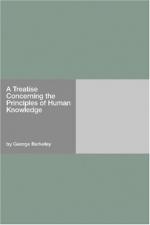43. But, for the fuller clearing of this point, it may be worth while to consider how it is that we perceive distance and things placed at a distance by sight. For, that we should in truth see external space, and bodies actually existing in it, some nearer, others farther off, seems to carry with it some opposition to what has been said of their existing nowhere without the mind. The consideration of this difficulty it was that gave birth to my “Essay towards a New Theory of Vision,” which was published not long since, wherein it is shown (1) that distance or outness is neither immediately of itself perceived by sight, nor yet apprehended or judged of by lines and angles, or anything that has a necessary connexion with it; but (2) that it is only suggested to our thoughts by certain visible ideas and sensations attending vision, which in their own nature have no manner of similitude or relation either with distance or things placed at a distance; but, by a connexion taught us by experience, they come to signify and suggest them to us, after the same manner that words of any language suggest the ideas they are made to stand for; insomuch that a man born blind and afterwards made to see, would not, at first sight, think the things he saw to be without his mind, or at any distance from him. See sect. 41 of the fore-mentioned treatise.
44. The ideas of sight and touch make two species entirely distinct and heterogeneous. The former are marks and PROGNOSTICS of the latter. That the proper objects of sight neither exist without mind, nor are the images of external things, was shown even in that treatise. Though throughout the same the contrary be supposed true of tangible objects—not that to suppose that vulgar error was necessary for establishing the notion therein laid down, but because it was beside my purpose to examine and refute it in a discourse concerning vision. So that in strict truth the ideas of sight, when we apprehend by them distance and things placed at a distance, do not suggest or mark out to us things actually existing at a distance, but only admonish us what ideas of touch will be imprinted in our minds at such and such distances of time, and in consequence of such or such actions. It is, I say, evident from what has been said in the foregoing parts of this Treatise, and in sect. 147 and elsewhere of the Essay concerning Vision, that visible ideas are the Language whereby the governing Spirit on whom we depend informs us what tangible ideas he is about to imprint upon us, in case we excite this or that motion in our own bodies. But for a fuller information in this point I refer to the Essay itself.




